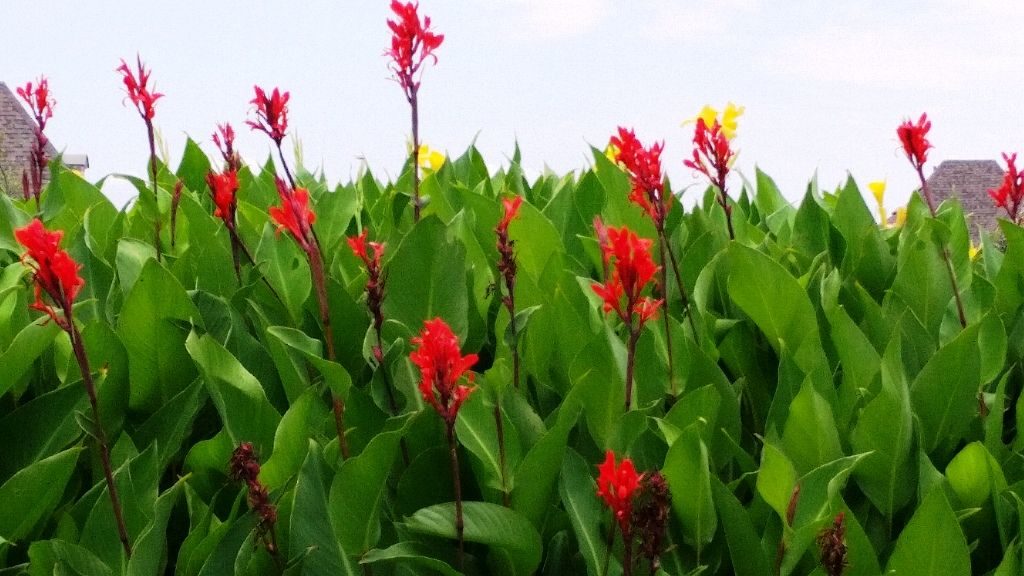
mainstreetlawn
Tropical Landscaping in North Texas
The allure of tropical landscaping is felt throughout north Texas. With our hot and humid summers, many homeowners are drawn to tropical landscaping and the selection of plants throughout our area certainly provides many choices for these lush, summer flowering plants. The majority of tropical plants will survive the longest within plant hardiness zones 9-11. Our north Texas area sits predominantly in plant hardiness zone 8. This means that we will experience colder temperatures than our neighbors to the south, so we have to select our tropical plants carefully and adjust our expectations for their life expectancy. For example, a Hibiscus planted in San Antonio might provide blooms and foliage throughout the year, but the same Hibiscus planted by even the best Frisco landscaper might only provide the same interest until November when it would shed all of its leaves until the following spring. We have provided a list below of some great north Texas tropical landscaping plants and information on what to expect from them and how to care for them.
Palm Trees
Palm trees are one of the most controversial landscaping plants in north Texas. More palm trees are lost each year due to irresponsible planting and winter neglect. If you have hired a professional landscaper to install your plants, they should have advised you of two critical pieces of information regarding palm trees. Number 1: not all palm trees will survive in north Texas. The Needle Palm, Windmill Palm and Pindo Palm are the three most adapted to plant hardiness zone 8. Any other palm trees planted in our zone will likely perish during our winter season. Number 2: all palm trees should be wrapped in burlap during the winter season, even the palms that we listed as being hardy in our area. Wrapping the trunks of your palms in burlap during the winter essentially provides them with a winter jacket and will ensure their continued comfort and health during the chilly season. Plan to prune your palm trees of their lowermost fronds each year to keep them tidy.
Oleander
Considered an evergreen shrub, the Oleander grows to an impressive 12 ft in height and can spread out to a width of 8 ft. While the Oleander can show some freeze damage during very harsh winters, its leaves will remain green year-round and offer up gorgeous blooms throughout the spring and summer months. In addition to its impressive size and vibrant summer blooms, the Oleander also offers drought tolerance. The one significant drawback to be aware of is the Oleander’s poisonous nature. No parts of this plant should be ingested.
Canna
One of the showiest and most impressive perennials, the Canna brings a tropical flare to any full-sun area of your landscaping. As a perennial, the Canna dies back each year with the first frost, most often late November and reemerges each spring. The Canna provides unmistakable foliage with large green, red or variegated leaves. Equally impressive are the tropical blooms on display from April through September. When designing a garden, give the Canna a spot towards the back of your garden as they will grow to an impressive 6 ft in height and each plant can spread out to about 3 ft in width…and they will do that every single year.
Banana Plant
The Banana provides the most impressive tropical foliage in our area. Growing to an unbelievable 8-12 ft tall and 3 ft wide, the Banana falls in a special category of annual/perennial, meaning that the severity of our winter season and freezing determines whether it will return or die back permanently. However, as one of the easiest plants to grow, it’s worth the risk. The best way to protect your Banana plant through the winter will be to cut it back all the way to the ground before the first freeze and cover it with mulch. The pruning and mulch cover will keep it safe through the cold season. You should see new life emerge in April.
Mandevilla
The Mandevilla is considered a tropical vine, providing lush green, large-leafed foliage and stunning pink flowers that bloom throughout the summer and fall. While the Mandevilla can grow to 8 ft in height, keep in mind that it’s an annual. This means that your Mandevilla will likely die during our very first freeze. Rather than planting the Mandevilla directly in the ground, we suggest planting in a pot close to an arbor or a pole that it can climb during the growing season. If you are able to confine its growth to a pot, you might be able to extend its life a bit by bringing the pot to a warmer place and covering it during the cold season.
Tropical landscaping is absolutely possible in north Texas and many tropical plants can be enjoyed year round. When planning for a tropical landscape, know the plant hardiness zones, growth habits and most importantly, how to care for your tropical plants during the cold season. Taking the time to protect your tropical plants during the winter months will ensure you can enjoy the tropical look for years to come.
Share this post
© 2024 · Main Street Lawn Care and Landscaping, LLC

